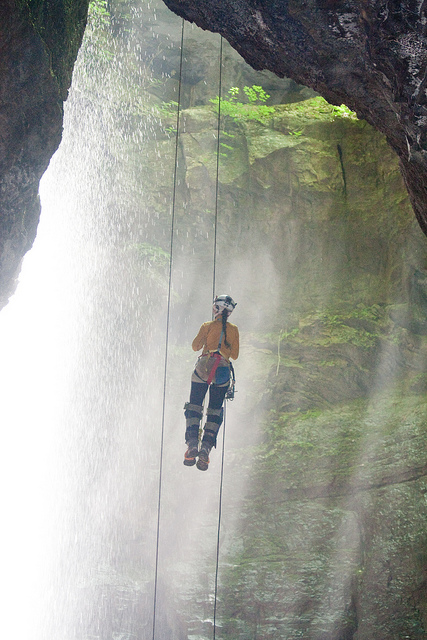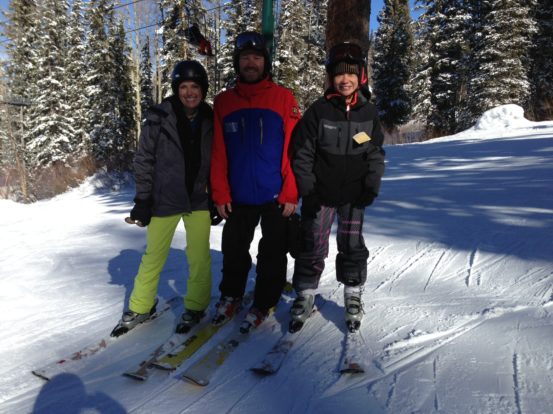
Caves like Stephens Gap in Alabama, are the reason I learned to rappel. Although I have rappelled it, that’s not me. Photo credit – Jeff Hunter via Flickr
Inaction breeds doubt and fear. Action breeds confidence and courage. If you want to conquer fear, do not sit home and think about it. Go out and get busy. ~Dale Carnegie
Boots planted on the ledge, harness checked, and my hand holding the rope in a brake position over the bar rack, I took a deep breath to settle my nerves. Listening to my patient instructor’s reassurances, I leaned back over the ledge, unwound the rope and slowly allowed it to slide through my hand. As my butt lowered beyond the ledge, I took a quick step onto the side of the wall, probably the most unnerving part of the rappel. From there I found my pace sliding down the rope. Touching the ground 70 feet below, I was both relieved and proud. Nevertheless, I wasn’t done. Back up the stairs and back down the rope I went, repeatedly, until I wasn’t afraid anymore.
Caving sharpened my rappelling skills, as did my stint as a high-angle rescue technician for Orange County Fire Rescue. Eventually, I was teaching others the sport. Looking back it’s hard to believe the level of fear I felt the first time I leaned back over that wall.
Managing fear is part of enjoying adventure sports. It’s the secret sauce that keeps some people away while attracting others. I’ve found that the first exposure to a sport is more intense because everything is unfamiliar and your mind and body are struggling to process the new stimulus. The last sport I learned was whitewater kayaking 13 years ago. I decided I was WAY overdue for a new challenge recently, so I decided to try downhill skiing. I suspected it would provoke my fear of heights and I was right.
During the first day of lessons, I owned the learner’s hill, but yesterday I moved to steeper slopes and my fears crept in. I had visions of careening out of control, plowing over 4-year-old skiers on my way down the mountain. Ya, I became a big baby – in my head. Back to reassuring instructors…luckily Brighton’s Snowsports School has them. Additionally, I reverted to what I always do, take a deep breath, stay calm, and don’t quit. After the lesson was over I wanted to load up and go home, but instead I climbed back on the lift for another run.
I’ve found that when learning something difficult, the worst time to quit is when you most want to. That is exactly when you should resolve yourself and try again. Otherwise, you might never go back. The important thing is to calm down first. I stopped, had lunch, ran through my head what I was doing incorrectly and how to do it right. Then I reminded myself that I had already tumbled head-over-heels twice and it just made me laugh. So why be afraid?
On the ride up, the silence was surprising. It reminded me of my first solo flight when I talked to myself just to stay calm. At the top, I had time to take pictures now that I was alone. Skiing down was peaceful and I only fell gently one time (unlike my “yard sale” earlier in the day). With that, I allowed myself to go home and relax. Today I am resting my muscles and catching up on work. However, if you’re skiing Utah’s Brighton Resort tomorrow, watch out for a chick in chartreuse pants careening down the slopes…. Just kidding!
Here are three tips for managing fear when trying a new adventure sport:
Own It and Feel It
Don’t pretend that everything is okay. It’s acceptable to be afraid. By acknowledging your fear, you can deal with your body and mind’s reactions better. For example, that churning in your tummy isn’t a bad burrito; you’re experiencing a common physical reaction to fear. No need for more anxiety thinking you’re getting sick too.
Take Action
Dwelling on what scares us only makes it worse, instead get out and take action. No, you won’t enjoy it at first – that will come later. This is the principle behind my getting back up on the mountain. I knew that the more I skied the less it would scare me. In fact, the last run down the mountain was pretty nice. What if I had quit and gone home? I might be dreading my lesson tomorrow.
Take other actions to calm your fear if you can’t jump into the sport right away. The best is exercise, because it will also help prepare you for the challenge. Nervous about mountain climbing this summer? Get to the gym. The physical activity will calm your nerves and get your body ready.
Listen and Breathe
Fear has the tendency to impair our ability to listen. Not cool considering many adventure sports can be dangerous if you don’t pay attention. Be aware of this and make a point of taking deep breaths and actively listening to instructions. If you don’t understand something, say so. Take deep calming breaths, in through your nose and out through your mouth as you begin. Soon, you’ll be comfortable and grinning like a Cheshire cat.
Do you have any tricks for managing fear when trying something new? Please share them below.
For an update on how I did during the remainder of my ski lessons, read Learning to ski: Three days of fun at Brighton’s Snow Sports School.



Comments 5
When I visited Salt Lake City, we met a couple people and reference was made to a few others who had recently had some pretty serious accidents while skiing. This did not help my nerves, but fear can be a good thing as you say. It makes you more cautious while you are learning.
My biggest fear was also hurting someone else. At one point I went flying down a hill and yelled “oh sh#t” as I barely missed a guy. That had to be unnerving for him, but I was able to miss him and gain control. Good luck on the slopes.
Thx for the good wishes. By the end of my third day I finally felt comfortable turning on easy blue runs and started to have a great time with it. I’ll still need time to become completely at ease.
Skiing is similar to riding a bicycle. It’s tough at first and takes practice. Eventually, it becomes natural. I went years without skiing, and it came right back.
Pingback: Learning to ski: Three days of fun at Brighton's Snow Sports School
Pingback: Learning to ski: Three days of fun at Brighton's Snow Sports School | The Active Explorer